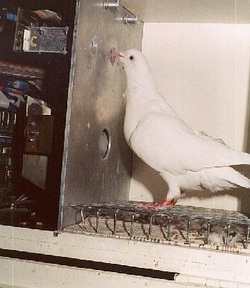Learning theory
Superstition in the Pigeon

Skinner placed many hungry pigeons in a cage attached to an automatic mechanism that delivered food to the pigeons "at regular intervals with no reference whatsoever to the bird's behavior". He discovered that the pigeons associated the delivery of the food with whatever chance actions they had been performing as it was delivered, and that they continued to perform the same actions:
One bird was conditioned to turn counter-clockwise about the cage, making two or three turns between reinforcements. Another repeatedly thrust its head into one of the upper corners of the cage. A third developed a 'tossing' response, as if placing its head beneath an invisible bar and lifting it repeatedly. Two birds developed a pendulum motion of the head and body, in which the head was extended forward and swung from right to left with a sharp movement followed by a somewhat slower return.
Skinner suggested that the pigeons believed that they were influencing the automatic mechanism with their "rituals" and that the experiment also shed light on human behavior: The experiment might be said to demonstrate a sort of superstition. The bird behaves as if there were a causal relation between its behavior and the arrival of food, although such a relation is lacking. The food would appear as often if the pigeon did nothing - or, more strictly speaking, did something else. There are many analogies in human behavior. Rituals for changing one's luck at cards are good examples.
One bird was conditioned to turn counter-clockwise about the cage, making two or three turns between reinforcements. Another repeatedly thrust its head into one of the upper corners of the cage. A third developed a 'tossing' response, as if placing its head beneath an invisible bar and lifting it repeatedly. Two birds developed a pendulum motion of the head and body, in which the head was extended forward and swung from right to left with a sharp movement followed by a somewhat slower return.
Skinner suggested that the pigeons believed that they were influencing the automatic mechanism with their "rituals" and that the experiment also shed light on human behavior: The experiment might be said to demonstrate a sort of superstition. The bird behaves as if there were a causal relation between its behavior and the arrival of food, although such a relation is lacking. The food would appear as often if the pigeon did nothing - or, more strictly speaking, did something else. There are many analogies in human behavior. Rituals for changing one's luck at cards are good examples.
